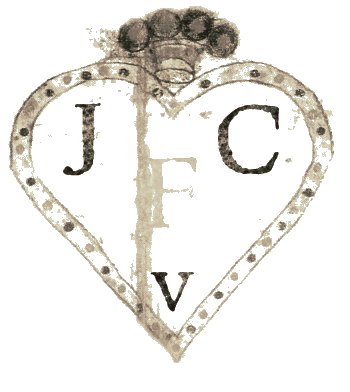|
History
There seems to have been a community of Conventual Franciscans in Venice by
1225, and in 1234 Giovanni Badoer gave the friars (or Frari) some
marshy land between the parishes of San Toma and San Stin. Then Doge Jacopo Tiepolo gave them some
adjoining unreclaimed land in 1236,
adjacent to the abandoned Benedictine abbey that they were using. The
church that they built, consecrated in 1280, was much smaller than
the one we see today, standing on the site of the nave of the current
church, and faced in the opposite direction, towards the
north-east. The current
church was begun shortly after, in 1340, but work was slow - the old church was still
being used in 1415, but it was demolished shortly after this date to
complete the east end of the nave, work having been begun at the west end. The new
church was finished in 1442 - its façade finished around this time - and
finally consecrated in 1492. Its plan is attributed to Fra Scipione Bon, who has a tomb in the church. The monastery dates from 1256,
being renovated after a fire in 1390 and having two cloisters, one by
Jacopo Sansovino and the other attributed to Andrea Palladio.

The church
The exuberant, but
brick-plain, Gothic façade contrasts with the more restrained façade on
the Dominican’s
San Zanipolo, built at the same time.
It is divided into three parts, reflecting the nave and aisles, with
circular windows in each. Over the arch of the doorway is a 1581 Risen
Christ by Alessandro Vittoria, flanked lower down by The Virgin
and Saint Francis by Bartolomeo Bon in the 15th century. The
barely-there lunette fresco is The Virgin Among Angels by Gaetano
Zomponi from the 18th century.
Stand in the campo
in front of the façade to see the sequence of three entrances and three oculi windows (see
photo right) with the
stout campanile rising above the middle one. Of the three doorways the
furthest, to the chapel of San Marco, has the most impressive decoration -
A Virgin and Child Flanked by Angels once thought to be by Jacopo
della Quercia, but lately given to Bartolomeo Bon.
In the Campo San Rocco at
the other end you can admire the Gothic apse (see old black & white
postcard far below). Its mouldings were said by Ruskin to be the
source of similar designs on the Palazzo Ducale.
Interior
The twelve huge round pillars between the nave and the aisles represent
the apostles, but the division of the nave and aisles is pretty unobtrusive,
giving the impression of a single space dissected up high by tie-beams.
The tie-beams are there for stability in a sinking city. And here the bricks have been painted to
mask their humble nature. Dominating the centre of the church is the dark
wood of the monumental monks’ choir (a rare survival in Venice) erected in
1468. The 124 choir stalls feature fine carving and intarsia by Marco Cozzi,
depicting views of an ‘ideal city’. This choir for the friars is separated
from the nave of the lay congregation by a carved marble screen of 1475, an early work from the
workshop of Pietro Lombardo.
This screen is strictly to be called a pulpitum, as it has a marble
pulpit at each end, and is the best preserved example of such tramezzi,
most of which were destroyed in Italy in the late 16th century.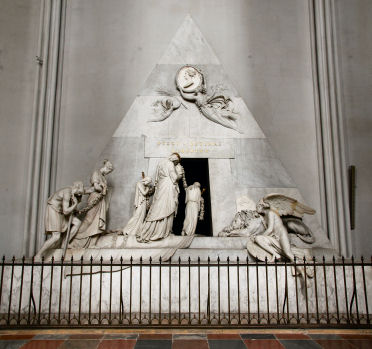
The nave features some mighty
overpowering tombs, the most exhausting being the one for Doge Giovanni Pesaro, designed by Longhena, with the four huge moors bent under a weight
of allegorical figures under a canopy of carved ‘brocade’. The
pyramidal tomb to Canova is a far calmer and lovelier thing, if not
exactly unwacky itself. Its design was copied by his pupils from the
memorial Canova created for Maria Christina, daughter of Empress Maria Theresia, in the Augustinerkirche in Vienna (see
photo right). Canova's heart is
preserved in a barely-visible
porphyry urn behind the
sinister open door, although the rest of him is buried in Possagno, with a
finger said to be in the Accademia.
Opposite is the tomb of Titian (erected by the Emperor of Austria in the
19th century) and, a few altars along, Vittoria's statue
of Saint Jerome is said to depict Titian at 90. According to the parish records of San Canciano
he died in August 1576 of a fever. He was buried here
despite the fact that funeral services were prohibited during times of plague for fear
of contagion. The plague restriction also probably being the reason that his
desire to be buried in his hometown weren't observed.
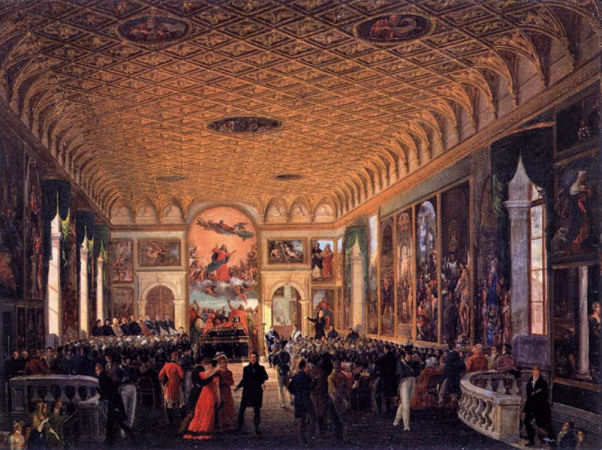
Titian’s Assumption over the main altar in its enormous limestone
frame (the work of Lorenzo Bregno and his brother Giambattista) dominates the
church, and is said to be the largest altarpiece in Venice. His working for the nearby (also Franciscan) church of
San Nicoletto
della Lattuga (now demolished) may partially explain how such a prestigious commission went
to a relatively untested artist. Some sources claim that it was his first
public commission. It was commissioned to go above the high altar erected
in 1516, the year that Giovanni Bellini died, Giorgione and Sebastiano del
Piombo having been dead and departed to Rome, respectively, for a few
years too. These facts may also explain why Titian got the job. It was installed by 1518. The ornate frame is topped by a
sculpted Risen Christ flanked by the figures of Saints Francis and
Anthony of Padua all life-sized. Ruskin later said that this painting was 'not one whit the better for
being either large or gaudy in colour' and complained of its excess of
'fox colour'. The friars who commissioned it (led by the prior, Fra
Germano da Casale) were a bit shocked too, at its groundbreaking vigorous Virgin.
also
telling Titian that his apostles were too big in relation to the Virgin - but they stopped
complaining when Titian-fan Emperor Charles V expressed an interest in buying it. It spent
some time during
the 19th century as the highlight of the Accademia gallery, where it was
moved in 1816 for reasons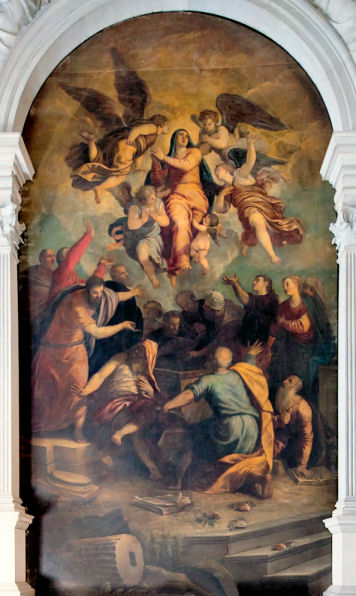 of preservation and easier access.
It was initially the pride of Room 1, as shown in a painting by Giuseppe Borsato
(see above) and then room 2 was built to house it. It returned here in 1919. An
Assumption by Salviati from the demolished church of
Santa Maria dei Servi
had taken its place during its long absence. Salviati's painting, now in
the Rosary Chapel in
San Zanipolo
(see photo right) had had
to have a two metre high panel added so as to fit in Titian's original's
frame, painted by Venetian painter and restorer Antonio Florian with steps and column debris.
of preservation and easier access.
It was initially the pride of Room 1, as shown in a painting by Giuseppe Borsato
(see above) and then room 2 was built to house it. It returned here in 1919. An
Assumption by Salviati from the demolished church of
Santa Maria dei Servi
had taken its place during its long absence. Salviati's painting, now in
the Rosary Chapel in
San Zanipolo
(see photo right) had had
to have a two metre high panel added so as to fit in Titian's original's
frame, painted by Venetian painter and restorer Antonio Florian with steps and column debris.
Along with this early triumph
there's the slightly later and much quieter, but no less impressive, Pesaro
Altarpiece (see far right) which Ruskin thought to
be the artist's best work in Venice. Jacopo Pesaro's mixed motives for
commissioning the altarpiece included his bitterness at not receiving due
credit for his part in defeating the Turks at Santa Maura in 1502, and
that instead the glory had fallen upon his cousin Benedetto Pesaro, one of
the brothers who commissioned the Bellini altarpiece mentioned below,
which he may also have wanted to outdo. Jacopo belonged to the dal Carro
branch of the family and it was the San Benetto branch who had commissioned
the Bellini. Figures at the top of the frame hold the family coat of arms
and bishops' mitres, the latter to commemorate Jacopo's holding the
honorific title of Bishop of Paphos. This frame is also, like the
Assunta's, thought to be the work of Lorenzo Brego.
These career highlights, along with his
over-the-top tomb, gives rise to the Frari being known as 'Titian’s church'.
The Crucifix in the presbytery was restored in 1992, to commemorate
the 500th anniversary of the church's consecration. Beneath 19th-century
repainting a 13th-century crucifix was found, painted in tempera.
Palma Giovane's 1595 Martyrdom of Saint Catherine, over an
altar in the
right aisle, was unsatisfactory to
the friars at first, but they were talked around by Alessandro Vittoria who had recommended
the artist to them. It is a bit violent, which is why they objected to.
Two sculptures of John the Baptist, one by Donatello and the other by Sansovino, are equally impressive, as are works by Bartolomeo Vivarini
(including his last, the Saint Mark Triptych, in the last lateral chapel to the right of the altar) and his
nephew Alvise (whose final work is to be found in the first lateral chapel
from the left). This last work, the Saint Ambrose altarpiece of
c.1503, was
commissioned for the chapel of the Scuola Milanese, and was
finished after Alvise's death by Marco Basaiti, upon which fact is based
otherwise shaky theories that Basaiti was a pupil of Alvise. The painting celebrates
Saint Ambrose, the patron saint of Milan, and was the biggest altarpiece in
Venice before Titian's Assumption.
The Sacristy is accessed through the door at
the end of the right transept which is the centre of the tomb of Benedetto Pesaro. The Sacristy (see photo right) was the Pesaro family chapel
from 1478. Upon entering you are confronted by Francesco Cabianca's 1711
reliquary altar, in the centre of which is the relic of the Magdalene's
oil mixed with Jesus's blood collected under the cross. This was bought by
Melchiorre Trevisan in Istanbul in 1480, on the same trip that he took
Gentile Bellini to the court of Sultan Mehmet II. The marble wall
tabernacle where the miraculous relic was originally kept is in here too.
In the apse of the Sacristy is a Giovanni Bellini altarpiece to contemplate at length,
a Virgin and Child with Saints (also known as the Frari Madonna).
It has
that same power to calm as his later altarpiece in
San Zaccaria,
despite a
somewhat overpowering frame, probably designed by Bellini himself and
carved by Jacopo da Faenza. But the architectural weight of the frame, and
the way it blends with the pictorial space, helps the feeling of unified
space, as does the lack of a historiated predella. Bellini was reputedly not good at painting
movement, which 'limitation' gives us something to rest in front of
(chairs are provided) after his pupil Titian’s more kinetic works. The
Franciscans tended to stress the Virgin's exalted and chosen state, as the
Titian Assumption illustrates. This Bellini seems more in keeping
with the Dominicans' idea of a more human Virgin but he has, probably at
the Franciscans' request, painted Saint Benedict with his bible open at
the first chapter of Ecclesiastes, which is the strongest source for the
controversial theory of the immaculate conception. Pietro Pesaro's sons
commissioned Bellini to paint the altarpiece in honour of their mother,
Franceschina Tron Pesaro, who had died in 1478 and who is buried here. The saints include the sons' namesakes - Nicholas,
Benedict (whose classical wall tomb we have just walked under) and Mark,
and the father's, Peter.
In the arch above the apse is an Annunciation fresco pair
attributed to Jacopo da Montagna dating to the late 15th century and
likely completed just before the Bellini triptych.
In the
Chapter House down steps off the sacristy is the tomb of
Doge Francesco Dandolo, with a Paolo Veneziano lunette panel of the
Virgin and Child Enthroned, with Saints Francis and Elizabeth of Portugal
(or Hungary) and Doge Francesco Dandolo and his wife (see right) from
1339, the
year of the Doge's death. Dandolo's widow Elisabetta commissioned Paolo
after her husband's death. In his will Francesco had stipulated that
'an honourable and proper tomb ought to be made for us, however with as
little pomp and vanity as possible, except that which is fitting for the
honour of Venice'.
From the Chapter House, beyond the Sacristy, it’s possible to glimpse the
Cloister of the Holy Trinity (see photo below), named for the
early-18th century wellhead topped by a sculpture group of The Trinity
by Francesco Penso, known as Cabianca. This sculptor also created statues
for the façade of the Gesuiti and for San Simeone Piccolo. This is one of
the two cloisters of the original convent which has housed the
Archivio di Stato, the Venetian state archives, since 1814 (after a period
of use as a barracks, post-suppression). The other is called the Cloister
of Saint Anthony and both are usually closed to visitors, although in July
2021 news came of
a state-funded building project to
extend access to the Archivio, as well as a Venice in Peril project to
restore the Trinity wellhead.

Campanile
69m (224 ft) electromechanical bells
The second highest in Venice, after that of San Marco, work on it began in 1361, to a design by Jacopo Celaga, and
was completed by
his son Pietro Paolo in
1396. It still looks like it did on the Barbari map (see right). It
was restored in 1871 after subsidence, with the foundations further
reinforced in 1903, following the collapse of the campanile of San Marco.
Half way up the campanile are a sculpted Virgin and a Saint
Francis Receiving the Stigmata. The three-light belfry is surmounted by an Istrian-stone balustrade and an octagonal drum.
Lost art
Formerly on the altar of of the Scuola di
Sant'Antonio here (first on the right) Saint Anthony of Padua with
Saint Bonaventure and the Blessed Luca Belludi, from c.1480 by Lazzaro
Bastiani is now in the Accademia. It shows Saint Anthony preaching to the
two Franciscan beati from up a nut tree, which he originally did
above his congregation - not a commonly-depicted episode from his legend.
The church in art (and not)
Canaletto, oddly, never painted the Frari; and Guardi only seems to have
only ever painted the cloister.
Monumento di Paolo Savelli nella Chiesa
di Santa Maria dei Frari a Venezia by Vincenzo Abbati (1857) (see
right)
There's a watercolour by John Singer Sargent of the Campo dei Frari
which depicts the campo and the side of the church and the two side
entrances. Outside the Frari, Venice by Walter Sickert, painted in
the late 1930s.
The Victoria & Albert Museum in London has a
watercolour called Chiesa del Frari, Venezia painted in the 1850s
by
Gabriel Mariano
Nicolai Carelli (see right) which, even more than the Abbati oil
painting above it, reproduces my favourite interior photo (far above
right).

Opening times
Monday to Saturday: 9.00 to 6.00
Sundays: 1.00 to 6.00
No longer a Chorus Church
Vaporetto
San Toma
map |
|
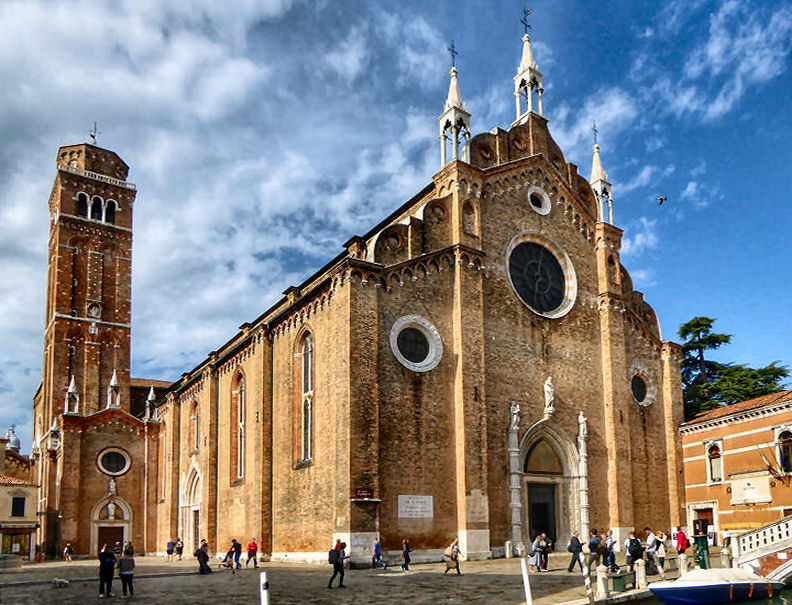
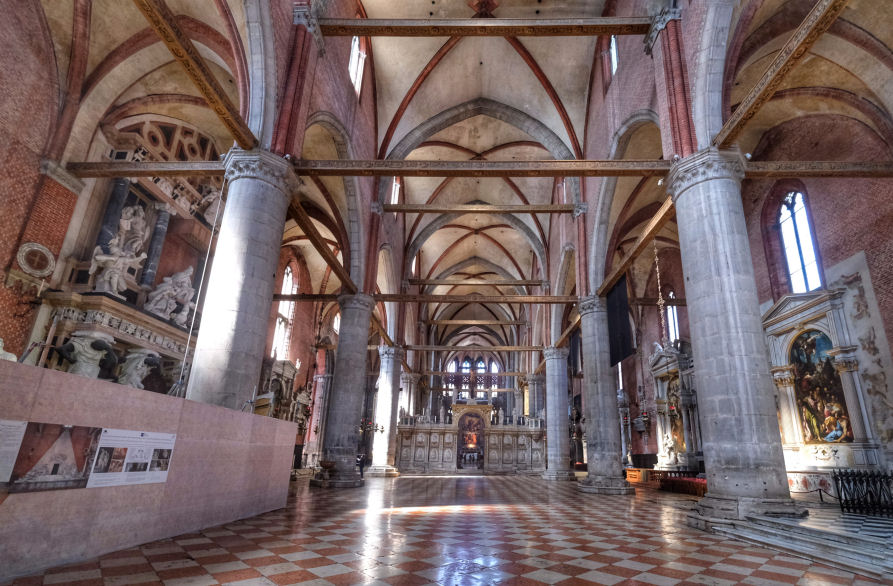

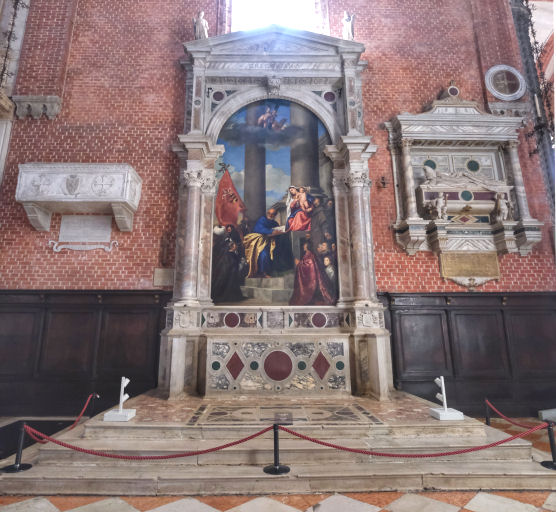
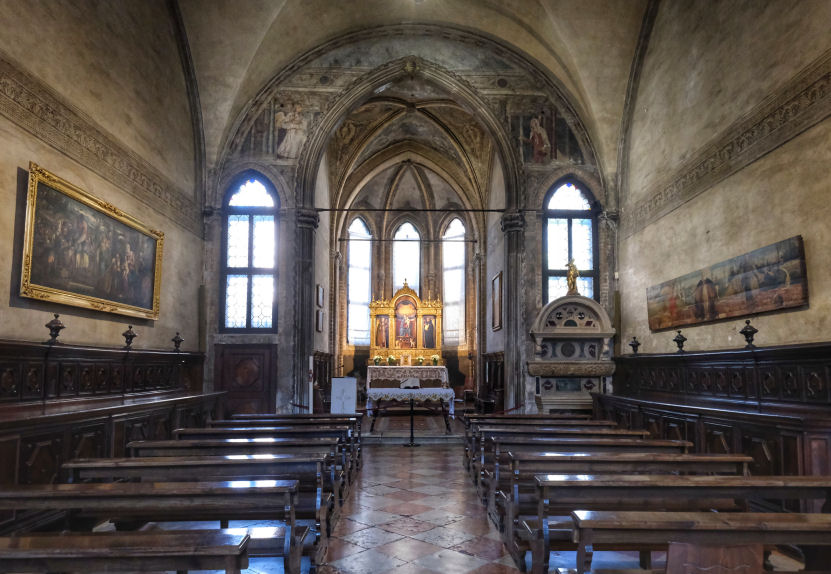
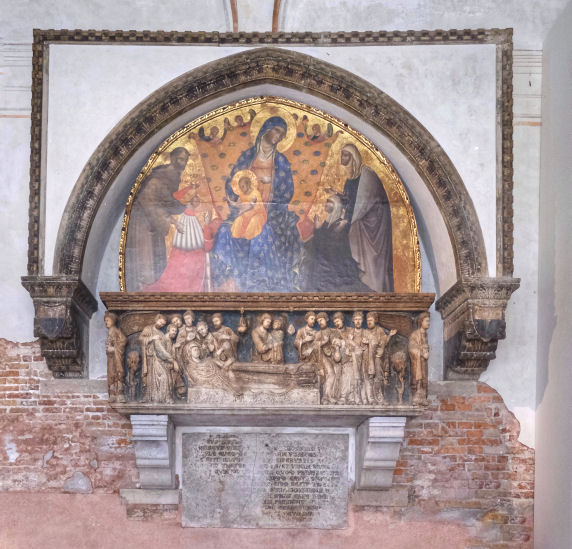
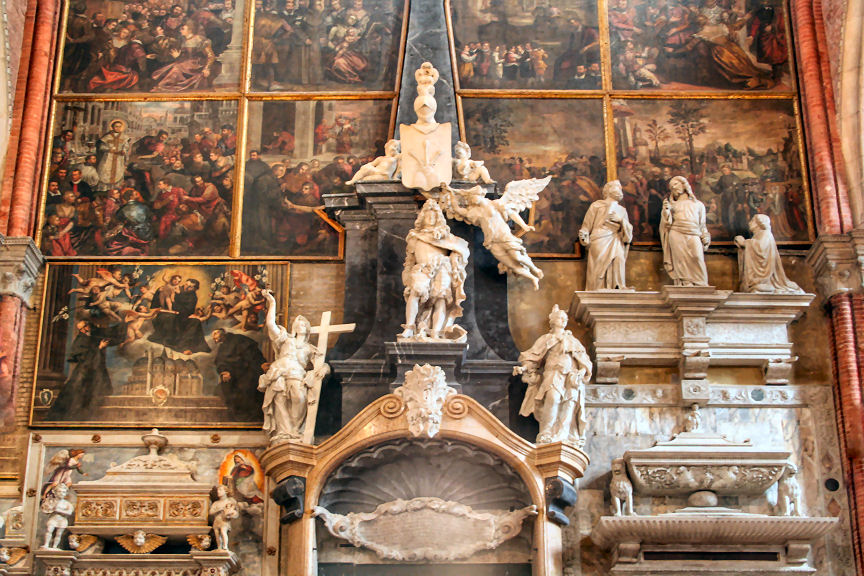
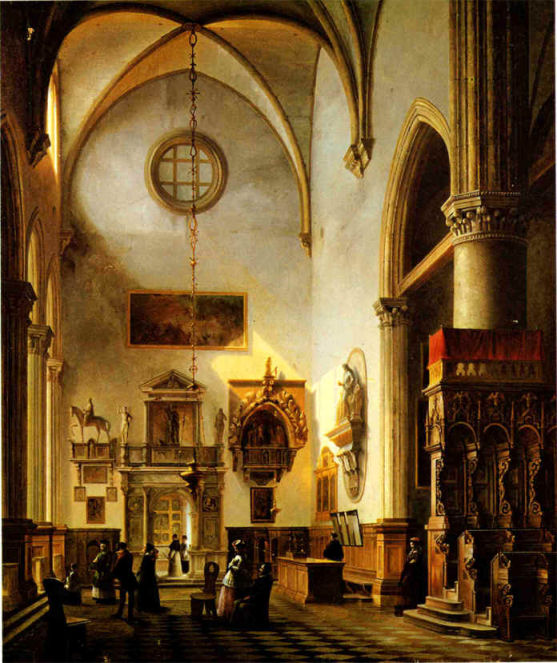
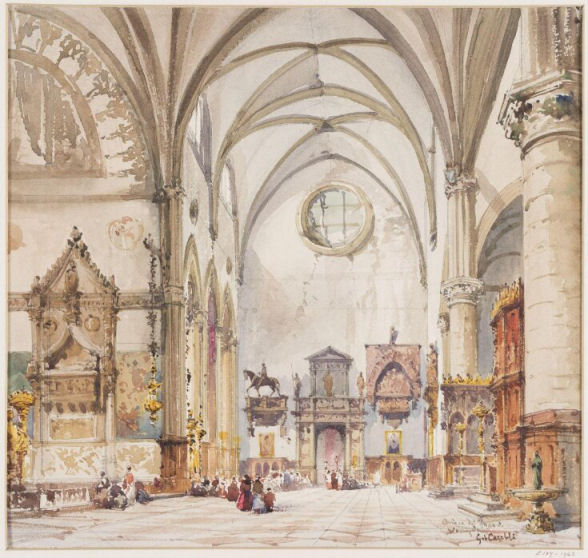
|

